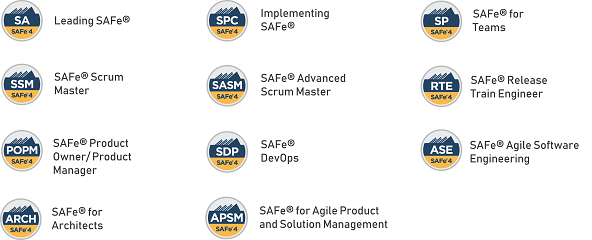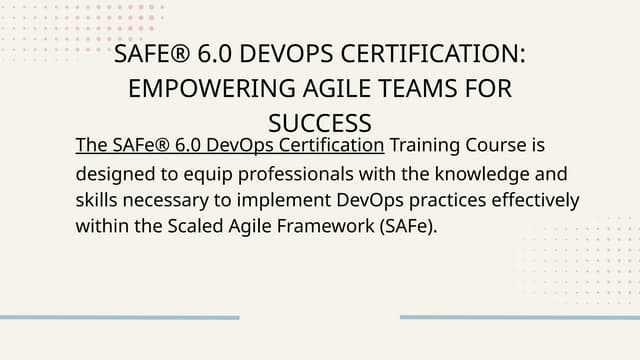Leading SAFe for Executives: Why It's Crucial for Enterprise Success
Wiki Article
SAFe Certification: Empowering Leaders in Scaled Agile Frameworks
The landscape of job monitoring is advancing, and SAFe Accreditation stands as an essential aspect for leaders looking for to carry out the Scaled Agile Structure efficiently. The journey to becoming a licensed SAFe leader entails even more than just getting expertise; it encompasses understanding the nuanced duties and duties within agile atmospheres.Understanding SAFe Qualification
SAFe certification, which means Scaled Agile Structure certification, is a credentialing program created to outfit professionals with the knowledge and skills required to apply agile methods at range within their companies. The SAFe structure supplies an organized strategy that aids companies straighten their teams and take care of bigger tasks properly, ensuring that agile methodologies are applied regularly across various levels.The accreditation incorporates different functions, including SAFe Agilist, SAFe Practitioner, and SAFe Program Specialist, each focusing on different aspects of the structure. The program emphasizes the significance of lean principles, continual distribution, and partnership among groups, promoting an atmosphere conducive to innovation and efficiency.

Participants go through rigorous training that incorporates theoretical expertise with useful application, boosting their ability to lead dexterous makeovers. The educational program consists of topics such as active groups, program execution, and profile management, ensuring that licensed specialists are well-versed in all aspects of the SAFe method.
Benefits of SAFe Qualification
Obtaining a Risk-free qualification offers various advantages for experts looking to improve their jobs in agile job management. Most importantly, it furnishes people with a comprehensive understanding of the Scaled Agile Framework, enabling them to properly implement nimble principles across big companies. This knowledge is essential as companies significantly adopt active methods to boost performance and flexibility.In addition, SAFe qualification boosts a prospect's bankability and occupation potential customers. SAFe DevOps certification. As organizations seek certified professionals to lead their agile transformations, qualified people can command greater wages and attract attention in an affordable task market. Additionally, acquiring this qualification shows a dedication to constant learning and expert development, which is very regarded by companies.
Networking opportunities additionally emerge from SAFe accreditation, connecting people with a neighborhood of similar specialists and sector leaders. This can bring about collaboration, mentorship, and expertise sharing, more enriching one's expert experience.
Lastly, accredited specialists are usually better outfitted to foster a society of cooperation and development within their groups, driving successful results in dexterous jobs. On the whole, the advantages of SAFe accreditation are manifold, making it a beneficial investment for those in the active task management domain name.
The Qualification Refine

Prospects are after that motivated to join a thorough training course, normally performed by a licensed SAFe fitness instructor. These courses cover vital ideas, concepts, and methods of the Scaled Agile Framework, giving participants with useful understandings and functional knowledge.
Following the training, prospects have to pass a certification exam to show their understanding and skills in applying SAFe concepts. The examinations are designed to assess not only expertise however also the capacity to carry out nimble practices effectively within a scaled setting.
Once licensed, individuals get to a wide range of sources, including area networks and ongoing learning possibilities, which better improve their agile leadership capabilities. Maintaining qualification needs continual expert growth, guaranteeing that leaders remain present with developing techniques within the framework. Eventually, the qualification process is a rigorous yet fulfilling path for those aiming to excel in dexterous management.
Functions and Duties
Reliable implementation of the Scaled Agile Structure (SAFe) counts greatly on clearly specified duties and duties within an organization. These roles are essential for ensuring alignment, effectiveness, and reliable collaboration throughout groups.At the group level, key functions include the Scrum Master, Item Owner, and Agile Team Members. The Scrum Master assists in the nimble procedure, ensuring that the team adheres to the SAFe principles while removing impediments. The Item Proprietor is in charge of making the most of the value of the product and managing the backlog to straighten with organization purposes. Agile Group Members add their specialized abilities to supply high-quality increments.
At the program degree, the Launch Train Designer (RTE) plays a crucial function in coordinating the Agile Launch Train (ART), making sure smooth program execution and alignment across numerous groups (SAFe Lean Portfolio Management). In addition, the system designer and company owner provide technological guidance and tactical vision, specifically
Continual Enhancement in SAFe
Continuous renovation is a keystone of the Scaled Agile Structure (SAFe), driving companies to improve their processes, items, and general performance. By cultivating a culture of continual renovation, SAFe motivates groups to consistently analyze their end results and workflows, recognize inefficiencies, and execute strategies for improvement. This iterative procedure not only improves productivity but likewise lines up teams with the company's strategic purposes.Central to this approach are the Inspect and Adapt (I&A) workshops, which supply structured chances for representation and knowing. Throughout these sessions, teams examine performance metrics, go over obstacles, and generate workable understandings to direct future versions. Furthermore, making use of Agile Release Trains (ARTs) assists in cross-functional partnership, allowing teams to share best techniques and drive collective improvement.
Moreover, Lean-Agile leadership plays an essential duty in advertising a state of mind of continuous improvement. Leaders are charged with cultivating an environment where testing is urged, and failures are watched as learning opportunities. By embedding constant enhancement into the business culture, SAFe empowers teams to stay receptive and agile to changing market demands, ultimately improving their capability to deliver value to customers.
Final Thought
In conclusion, SAFe Certification offers as a vital tool for leaders intending to implement active techniques efficiently within their companies. Ultimately, SAFe Accreditation adds dramatically to organizational success and strength.The landscape of job monitoring is evolving, and SAFe Accreditation stands as a crucial element for leaders seeking to carry out the Scaled Agile Framework properly.Obtaining a SAFe accreditation uses countless advantages for experts looking to boost their careers in agile project administration - SAFe For Architects. The Scrum Master promotes the active procedure, guaranteeing that the team adheres to the SAFe principles while removing impediments. By installing continuous improvement right into the business society, SAFe encourages groups to remain receptive and dexterous to changing market needs, inevitably boosting their capability to deliver worth to customers
In verdict, SAFe Certification offers as a vital device for leaders intending to execute nimble practices effectively within their companies.
Report this wiki page